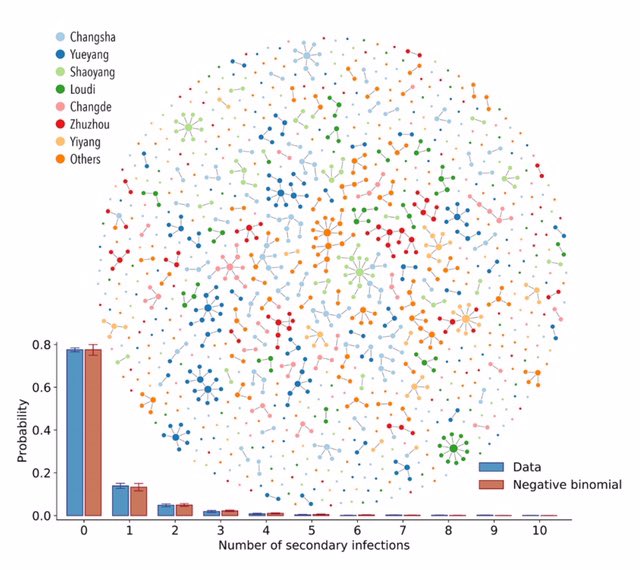This new paper on #sarscov2 transmission delves into the data from Hunan province and it is really interesting and the kind of data I would love to see more of. So a short thread https://science.sciencemag.org/content/early/2020/11/23/science.abe2424.full">https://science.sciencemag.org/content/e...
The authors used a dataset of 1,178 infected individuals and their 15,648 close contacts identified in Hunan province between January 16 and April 3 and reconstructed most likely transmission chains.
Superspreading:
The paper confirms previous work showing high overdispersion (so small minority of people leading to most onward transmission): “We find that 80% of secondary infections can be traced back to 15% of #SARSCoV2 infected individuals”.
Estimate k at 0.3
The paper confirms previous work showing high overdispersion (so small minority of people leading to most onward transmission): “We find that 80% of secondary infections can be traced back to 15% of #SARSCoV2 infected individuals”.
Estimate k at 0.3
Transmission risk:
Authors found household contacts at highest risk, then extended family, then social and community contacts. Healthcare contacts were lowest risk.
(Bear in mind that this depends on how people interact etc and can be different in different societies.)
Authors found household contacts at highest risk, then extended family, then social and community contacts. Healthcare contacts were lowest risk.
(Bear in mind that this depends on how people interact etc and can be different in different societies.)
Presymptomatic spread:
They estimate that 63% of transmission came before symptoms.
But people with symptoms were being isolated, curbing some late transmission: “We estimate that the relative contribution of pre-symptomatic transmission drops to 52% in an uncontrolled scenario”
They estimate that 63% of transmission came before symptoms.
But people with symptoms were being isolated, curbing some late transmission: “We estimate that the relative contribution of pre-symptomatic transmission drops to 52% in an uncontrolled scenario”
“Notably, we find that #SARSCoV2 infectiousness peaks slightly before symptom onset (-0.1 days on average), with 87% of the overall infectiousness concentrated within
±5 days of symptom onset and 53% of the overall infectiousness in the pre-symptomatic phase.”
±5 days of symptom onset and 53% of the overall infectiousness in the pre-symptomatic phase.”
Interventions:
Isolation and quarantine of
close contacts are effective but not enough. They “need to be layered with additional population-level measures, including increased teleworking, reduced operation in the service industry, or broader adoption of face masks”.
Isolation and quarantine of
close contacts are effective but not enough. They “need to be layered with additional population-level measures, including increased teleworking, reduced operation in the service industry, or broader adoption of face masks”.
Age and infections:
Authors find that “children aged 0-12 years are significantly less susceptible than individuals 26-64 years; while patients older than 65 years are significantly more susceptible”
But: No difference in infectivity.
Authors find that “children aged 0-12 years are significantly less susceptible than individuals 26-64 years; while patients older than 65 years are significantly more susceptible”
But: No difference in infectivity.

 Read on Twitter
Read on Twitter


